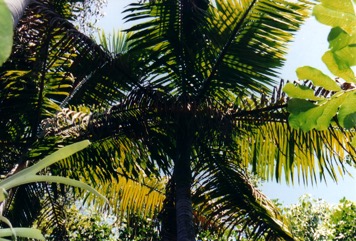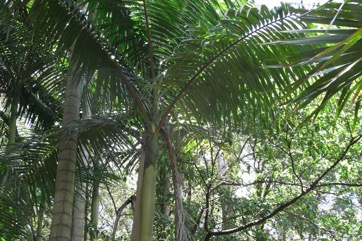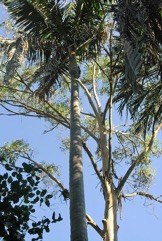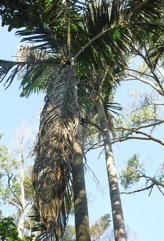Bangalow palm, Piccabeen palm

It is a warm temperate and subtropical plant. It grows along stream banks. In northern Australia it grows from sea level to 700 m altitude. They require well-drained soil. They need high humidity. It suits hardiness zones 10-11. In Melbourne Botanical Gardens.
Synonyms
- Seaforthia elegans
Edible Portion
- Shoots, Palm heart
Where does Bangalow palm grow?
Found in: Africa, Australia, Brazil, East Africa, Pacific, South America, Tasmania, United States, Zimbabwe
Notes: There are 6 Archontophoenix species.
Growing Bangalow palm, Piccabeen palm
Cultivation: Plants are grown from fresh seed. Seed germinate within 6 months. Seedlings do not transplant easily.
Edible Uses: The young shoots just coming out of the ground can be eaten raw. As this kills the palm it is not normally useful.
Production: Seedlings grow quickly.
Nutrition Info
per 100g edible portion| Edible Part | Energy (kcal) | Protein (g) | Iron (mg) | Vitamin A (ug) | Vitamin c (mg) | Zinc (mg) | % Water |
|---|---|---|---|---|---|---|---|
| Shoots | - | - | - | - | - | - |
Bangalow palm, Piccabeen palm Photos





References
Blomberry, A.M., 1979, Australian Native Plants. Angus and Robertson p 150
Blomberry, A. & Rodd, T., 1982, Palms. An informative practical guide. Angus & Robertson. p 48
Bodkin, F., 1991, Encyclopedia Botanica. Cornstalk publishing, p 96
Brickell, C. (Ed.), 1999, The Royal Horticultural Society A-Z Encyclopedia of Garden Plants. Convent Garden Books. p 131
Cooper, W. and Cooper, W., 2004, Fruits of the Australian Tropical Rainforest. Nokomis Editions, Victoria, Australia. p 67
Cronin, L., 1989, The Concise Australian Flora. Reed. p 205
Cronin, L., 2000, Australian Palms, Ferns, Cycads and Pandans. Cronin Publications. p 16
Cundall, P., (ed.), 2004, Gardening Australia: flora: the gardener's bible. ABC Books. p 174
Elliot, W.R., & Jones, D.L., 1982, Encyclopedia of Australian Plants suitable for cultivation. Vol 2. Lothian. p 224
Etherington, K., & Imwold, D., (Eds), 2001, Botanica's Trees & Shrubs. The illustrated A-Z of over 8500 trees and shrubs. Random House, Australia. p 101
Gibbons, M., 1993, Palms. Compact study Guide and Identifier. Sandstone. p 16
Gibbons, M., 2003, A pocket guide to Palms. Chartwell Books. p 36
Greig, D., 1996, Flowering Natives for Home Gardens. Angus & Robertson. p 56
Haslam, S., 2004, Noosa's Native Plants. Noosa Integrated Catchment Assn. Inc. p 320
Hearne, D.A., & Rance, S.J., 1975, Trees for Darwin and Northern Australia. AGPS, Canberra p 24
Hibbert, M., 2002, The Aussie Plant Finder 2002, Florilegium. p 31
Holliday, I., 1989, A Field Guide to Australian Trees. Hamlyn. p 60
Jones D, L, 1986, Ornamental Rainforest Plants in Australia, Reed Books, p 326
Jones, D.L., 1994, Palms throughout the World. Smithtonian Institution, Washington. p 57
Jones, D.L., 2000, Palms of Australia 3rd edition. Reed/New Holland. p 76
Lazarides, M. & Hince, B., 1993, Handbook of Economic Plants of Australia, CSIRO. p 23
Leiper, G & Houser, J., Mutooroo. Plant Use by Australian Aboriginal People. Assembly press, Queensland.
Linnaea 39:214. 1875
Lord, E.E., & Willis, J.H., 1999, Shrubs and Trees for Australian gardens. Lothian. p 92
Low, T., 1992, Bush Tucker. Australia’s Wild Food Harvest. Angus & Robertson. p 128
Melzer, R., & Plumb, J., 2011, Plants of Capricornia. Belgamba, Rockhampton. p 41
Molyneux, B & Forrester, S., 1997, The Austraflora A-Z of Australian Plants. Reed. p 46
Morley, B.D., & Toelken, H.R., (Eds), 1983, Flowering Plants in Australia. Rigby. p 394
Nicholson, N & H., 1996, Australian Rainforest Plants 2, Terania Rainforest Publishing. NSW. p 9
Recher, P, 2001, Fruit Spirit Botanical Gardens Plant Index. www.nrg.com.au/~recher/ seedlist.html p 7
Riffle, R.L. & Craft, P., 2003, An Encyclopedia of Cultivated Palms. Timber Press. p 27, 251
Townsend, K., 1994, Across the Top. Gardening with Australian Plants in the tropics. Society for Growing Australian Plants, Townsville Branch Inc. p 86
Williams, J.B., Harden, G.J., and McDonald, W.J.F., 1984, Trees and shrubs in rainforests of New South Wales and Southern Queensland. Univ. of New England, Armidale. p 19